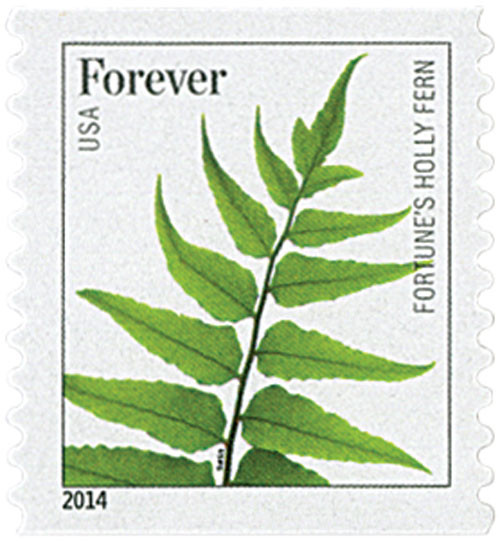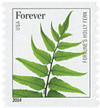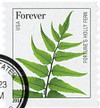
# 4977 - 2015 First-Class Forever Stamp - Ferns (with microprinting): Fortune's Holly Fern
U.S. #4977 OR U.S. #4977a
2014 & 2015 Ferns (with Microprinting): Fortune's Holly Fern
**Please Note: When you order this 2015 Fortune's Holly Fern stamp, you may receive US #4975 (from the coils of 3,000 with "2015" at the bottom of the stamp) OR #4975a (from the coils of 10,000 with "2014" at the bottom of the stamp).**
Thick and glossy in appearance, Fortune's holly fern fronds generally resemble holly leaves, thus the name. However, even though the most-recognized holly variety – associated with Western winter holidays – is native to Northern Europe, the holly fern comes from Southeast Asia.
Fortune's holly ferns were first introduced to Europe in the mid-19th century by Scottish botanist Robert Fortune. The 1842 Treaty of Nanjing opened China's borders to exploration by Westerners, and Fortune was sent by the British government to collect new plant samples for study. However, some believe that England, desiring freedom from China's tea-trade monopoly, actually sent Fortune to steal the Chinese secrets of tea production in one of the earliest-known cases of industrial espionage.
At the time, China permitted only restricted exploration and Fortune often disguised himself as a Chinese mercant in order to travel beyond the treaty port areas. Fortune eventually managed to smuggle tea plants out of China to the first tea plantations in India.
In addition to being credited with establishing the British tea industry, Fortune also managed to introduce over 120 species ofplants to the West, one of which was Fortune's holly fern.
U.S. #4977 OR U.S. #4977a
2014 & 2015 Ferns (with Microprinting): Fortune's Holly Fern
**Please Note: When you order this 2015 Fortune's Holly Fern stamp, you may receive US #4975 (from the coils of 3,000 with "2015" at the bottom of the stamp) OR #4975a (from the coils of 10,000 with "2014" at the bottom of the stamp).**
Thick and glossy in appearance, Fortune's holly fern fronds generally resemble holly leaves, thus the name. However, even though the most-recognized holly variety – associated with Western winter holidays – is native to Northern Europe, the holly fern comes from Southeast Asia.
Fortune's holly ferns were first introduced to Europe in the mid-19th century by Scottish botanist Robert Fortune. The 1842 Treaty of Nanjing opened China's borders to exploration by Westerners, and Fortune was sent by the British government to collect new plant samples for study. However, some believe that England, desiring freedom from China's tea-trade monopoly, actually sent Fortune to steal the Chinese secrets of tea production in one of the earliest-known cases of industrial espionage.
At the time, China permitted only restricted exploration and Fortune often disguised himself as a Chinese mercant in order to travel beyond the treaty port areas. Fortune eventually managed to smuggle tea plants out of China to the first tea plantations in India.
In addition to being credited with establishing the British tea industry, Fortune also managed to introduce over 120 species ofplants to the West, one of which was Fortune's holly fern.









